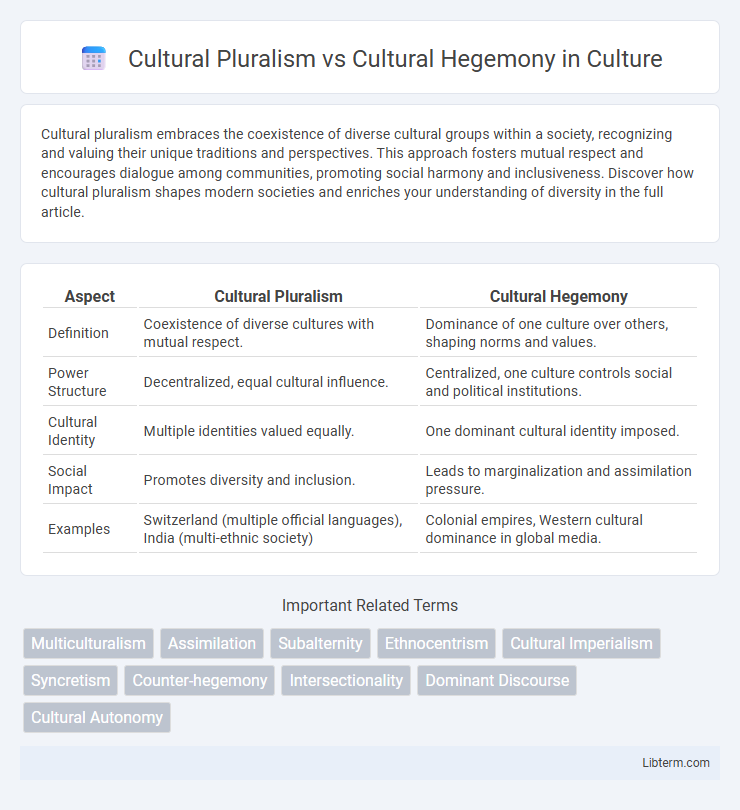Cultural pluralism embraces the coexistence of diverse cultural groups within a society, recognizing and valuing their unique traditions and perspectives. This approach fosters mutual respect and encourages dialogue among communities, promoting social harmony and inclusiveness. Discover how cultural pluralism shapes modern societies and enriches your understanding of diversity in the full article.
Table of Comparison
| Aspect | Cultural Pluralism | Cultural Hegemony |
|---|---|---|
| Definition | Coexistence of diverse cultures with mutual respect. | Dominance of one culture over others, shaping norms and values. |
| Power Structure | Decentralized, equal cultural influence. | Centralized, one culture controls social and political institutions. |
| Cultural Identity | Multiple identities valued equally. | One dominant cultural identity imposed. |
| Social Impact | Promotes diversity and inclusion. | Leads to marginalization and assimilation pressure. |
| Examples | Switzerland (multiple official languages), India (multi-ethnic society) | Colonial empires, Western cultural dominance in global media. |
Understanding Cultural Pluralism: Key Concepts
Cultural pluralism refers to the coexistence of diverse cultural groups within a society, where each group maintains its unique traditions, languages, and identities while participating equally in the broader social framework. It emphasizes mutual respect, inclusivity, and the recognition of cultural differences as valuable assets rather than threats. This concept contrasts with cultural hegemony, which denotes the dominance of one culture over others, often leading to the marginalization or assimilation of minority cultures.
Defining Cultural Hegemony: Origins and Influences
Cultural hegemony, a concept developed by Italian Marxist theorist Antonio Gramsci, describes the dominance of a ruling class's worldview imposed through cultural institutions, shaping societal norms and values to maintain power. It originates from the interplay between economic structures and cultural practices, where consent is manufactured rather than coerced, embedding ideology in education, media, and religion. This mechanism influences social control by marginalizing alternative belief systems, contrasting with cultural pluralism's emphasis on diverse and coexisting cultural expressions.
Historical Development of Both Ideologies
Cultural pluralism emerged in the early 20th century as a response to assimilationist policies, emphasizing the coexistence of diverse cultural groups within a society, notably influenced by the work of sociologists like Robert E. Park and Horace Kallen. Cultural hegemony, conceptualized by Italian Marxist theorist Antonio Gramsci in the 1920s and 1930s, highlights how dominant groups maintain power through cultural institutions, shaping ideology and social norms to sustain control. The historical development of these ideologies reflects a shift from celebrating multicultural coexistence to critically analyzing power dynamics and cultural dominance in shaping societal structures.
Major Theorists: From Antonio Gramsci to Contemporary Thinkers
Antonio Gramsci introduced the concept of cultural hegemony, emphasizing how dominant groups maintain power by shaping societal norms and values through cultural institutions. Contemporary thinkers like Stuart Hall expanded on Gramsci's ideas, examining cultural pluralism as a framework that recognizes diverse identities and resists homogenizing dominant cultures. This dialogue between cultural pluralism and hegemony remains central to understanding power dynamics, representation, and resistance in multicultural societies.
Cultural Pluralism in Modern Multicultural Societies
Cultural pluralism in modern multicultural societies emphasizes the coexistence and mutual respect of diverse cultural groups within a single social framework, promoting inclusion and equal participation. It supports the preservation of distinct cultural identities while fostering intercultural dialogue and collaboration. This approach counters cultural hegemony by challenging dominant cultural norms and encouraging a balanced power dynamic among various communities.
Mechanisms of Cultural Hegemony in Media and Education
Cultural hegemony operates through media and education by shaping dominant ideologies that maintain existing power structures, using selective representation and framing to normalize specific cultural values. Media outlets often prioritize narratives that reinforce ruling class interests, while educational curricula emphasize histories and knowledge that legitimize hegemonic worldviews. These mechanisms marginalize alternative perspectives, ensuring widespread internalization of dominant cultural norms.
Benefits and Challenges of Cultural Pluralism
Cultural pluralism fosters social cohesion by encouraging diverse ethnic groups to maintain their unique identities while participating equally in a shared society, enhancing creativity and mutual respect. Benefits include the promotion of inclusivity, reduction of prejudice, and enrichment of cultural experiences, which can lead to innovative problem-solving and economic growth. Challenges involve managing potential social fragmentation, overcoming language barriers, and addressing unequal power dynamics that may hinder true equality among cultural groups.
Critiques and Consequences of Cultural Hegemony
Cultural hegemony, as theorized by Antonio Gramsci, is critiqued for perpetuating social inequalities by establishing dominant groups' values as universal norms, thus marginalizing diverse cultural expressions. This dominance often results in the erasure of minority identities and the reinforcement of systemic oppression within societies. Consequences include reduced cultural diversity, limited social mobility, and the consolidation of power structures that resist pluralistic change.
Case Studies: Real-World Examples of Both Approaches
Cultural pluralism is exemplified by Switzerland, where multiple linguistic and cultural groups coexist with recognized autonomy, promoting diversity and social cohesion. In contrast, cultural hegemony is evident in China's policies toward ethnic minorities like the Uyghurs, where dominant Han culture imposes assimilation, suppressing distinct identities. These case studies highlight how pluralism fosters inclusive societies, while hegemony often leads to cultural conflict and resistance.
Striking a Balance: Moving Toward Inclusive Societies
Cultural pluralism promotes the coexistence of diverse cultural groups within a society, encouraging mutual respect and equal recognition of different traditions and identities. In contrast, cultural hegemony occurs when a dominant culture imposes its values and norms, marginalizing minority groups and limiting social inclusivity. Striking a balance involves implementing policies that protect cultural diversity while fostering shared values to create inclusive societies where all individuals feel represented and valued.
Cultural Pluralism Infographic

 libterm.com
libterm.com